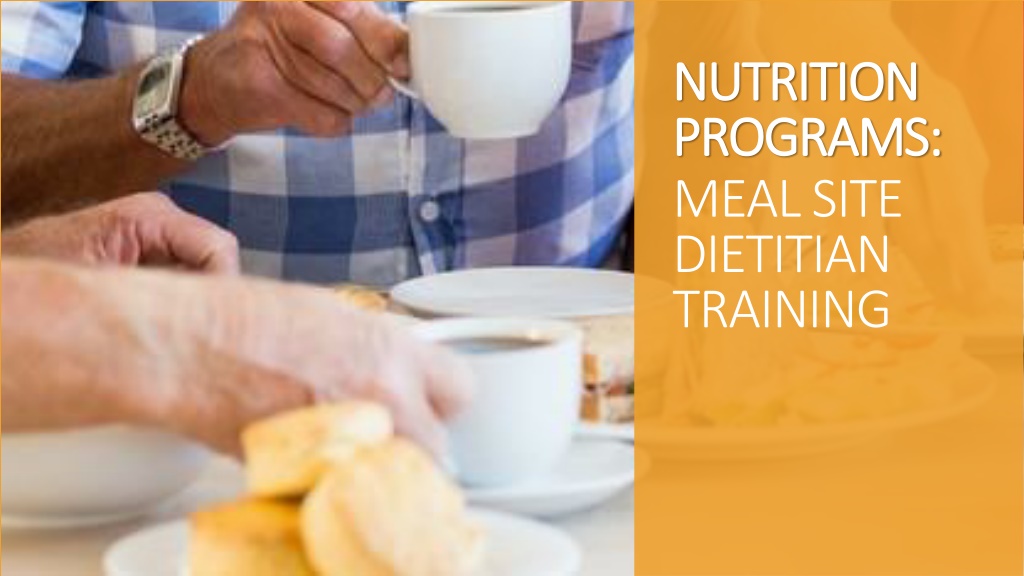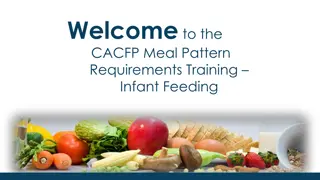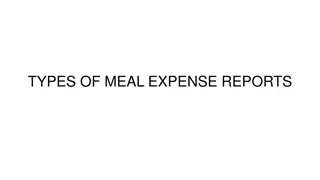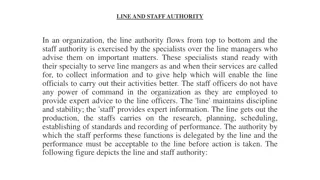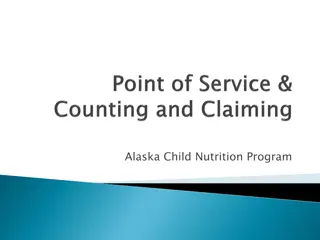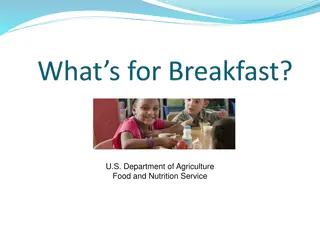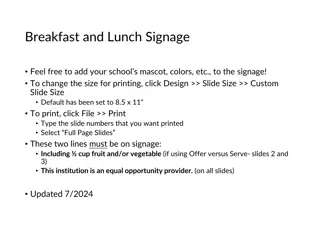Nutrition Programs and Guidelines for Older Americans
Nutrition programs and guidelines for older Americans, including dietitian training, menu planning, food cost management, and adherence to the Dietary Guidelines for Americans. Learn how the Older Americans Act supports nutrition initiatives to reduce hunger, promote socialization, and enhance the well-being of older individuals.
Uploaded on Nov 25, 2024 | 0 Views
Download Presentation

Please find below an Image/Link to download the presentation.
The content on the website is provided AS IS for your information and personal use only. It may not be sold, licensed, or shared on other websites without obtaining consent from the author.If you encounter any issues during the download, it is possible that the publisher has removed the file from their server.
You are allowed to download the files provided on this website for personal or commercial use, subject to the condition that they are used lawfully. All files are the property of their respective owners.
The content on the website is provided AS IS for your information and personal use only. It may not be sold, licensed, or shared on other websites without obtaining consent from the author.
E N D
Presentation Transcript
NUTRITION NUTRITION PROGRAMS: PROGRAMS: MEAL SITE DIETITIAN TRAINING
Dietitian Training for Dietitian Training for Meal Sites and Staff Meal Sites and Staff
REVIEW REGULATIONS AND DIETARY GUIDELINES DISCUSS MENU PLANNING, TEMPLATES AND MENU PLANNING HELP SHEET SANITATION: TO GLOVE OR NOT TO GLOVE..? Learner Learner Objectives Objectives FOOD COSTS.. HOW TO MAKE A DOLLAR GO FURTHER. HEATING / COOLING AND STORAGE DIETITIAN COUNSELING
Older Americans Act, S. Older Americans Act, S. 339.Nutrition A State that establishes and operates a nutrition project underthis chapter shall Utilize the expertise of a dietitian Provides meals that comply with the most recent Dietary Guidelines for Americans Provide a minimum of 33 and 1 3 percent of the dietary reference intakes established by the Food and Nutrition Board of the National Academies of Sciences, Engineering, and Medicine if the project provides one meal per day. To the maximum extent practicable, adjusted menus to meet special dietary needs of program participants. Including meals adjusted for cultural considerations and preferences and medically tailored meals. Encourage individuals who distribute nutrition services to provide homebound older individuals with available medical information approved by health care professionals, such as informational brochures and information on how to get vaccines, including vaccines for influenza, pneumonia, and shingles, in the individuals communities Link to the Older Americans Act
OAA Nutrition Program Goals Reduce hunger & food insecurity and malnutrition Promote socialization Promote the health and well-being of older individuals
Dietary Guidelines for Americans Dietary Guidelines for Americans The Dietary Guidelines for Americans provide evidence-based nutrition information and advice for people ages two and older to help Americans make healthy choices about food and beverages in their daily lives. The Guidelines also serve as the basis for federal food and nutrition education programs. The Dietary Guidelines for Americans, produced by the Department of Health and Human Services and the U.S. Department of Agriculture every five years, analyze the latest research to help Americans make smart choices about food and physical activity so they can live healthier lives. The link is provided here: https://www.hhs.gov/fitness/eat-healthy/dietary- guidelines-for-americans/index.html
Menu Menu Planning Planning
Menu Recommendations Menu Recommendations
Menu Recommendations Menu Recommendations
Menu Recommendations Menu Recommendations
Menu Recommendations Menu Recommendations Other Tips and Tricks: Use the format that works for you, but it must: Be in calendar layout Include portion sizes Include center name And list the month You can reuse previously approved menus; just let the dietitian know. You can submit several menus at a time, for instance quarterly.
Menu Recommendations Menu Recommendations Guidelines: Nutrition Guideline: Portion size must be included P= Meat or Protein 2 oz edible portion V= Vegetable C cooked or canned, or 1 C fresh F=Fruit C cooked or canned or 1 C fresh (High Vit A source 2-3x/wk) (high Vit C source daily) G=Grain/Bread 1/3-1/2 C or 1 slice/piece (half to be whole grain) D-Dairy 1 C milk or equivalent Dessert optional
Ounces Ounces - - vs Ounces are a weight measurement. We weigh items so that we don t have to grind and/or smash them into a scoop or measuring cup. These are items such as: vs - - Cups Cups Meats Breads and pastries If purchasing meats and breads pre portioned or pre-sliced then you will be able to determine the portion size from the packaging and will not have to physically weigh them. If slicing meat or making homemade bread - slice one that weighs the desired amount then use it as your guide for future slices. Cups should be used for all other measuring. (8 oz of lettuce would be about 5 cups, that s a huge side salad!)
Menu Recommendations Menu Recommendations Grains: 1 serving = 1 oz bread cup rice or pasta 2 servings are recommended per meal Check your bread labels and list the oz on the menu. Some are: 1.5 oz or even 2 oz. Rolls are often 2 oz. 1 oz of rice or pasta DOES NOT = 1 serving. (see the slide on ounces vs cups) Please do not list a roll every day for the 2 grains. This is boring for participants getting it on their plate day after day. Breading, gravy and oatmeal on dessert is counted as of a grain serving. More on grains on slide 18
Menu Recommendations Menu Recommendations Vitamin A and C (more on slide 17 & 20) cup vegetable doesn t provide enough information to ensure vitamin A and C recommendations are met. Be sure to list the vegetable or fruit that will be served. Including vitamin A and C items on the salad bar will help meet this recommendation. To cut down on space you can list just the items that are always offered and high in A and C. 4 oz Chicken Breast 1/2 Cup Broccoli 1 cup Salad Bar 1 Whole Grain Roll 1 cup Milk 4 oz Sloppy Joe with 2 oz Wheat Bun 1/2 cup peas 1 cup Salad Bar 1 cup Milk Salad Bar offered daily and always includes: lettuce, carrots, tomatoes, broccoli, variety of salad dressings However, specific vegetables still need to be listed to ensure variety of vegetables and fruits (and therefore vitamins and minerals) are offered.
Menu Recommendations Menu Recommendations As Defined by the Dietary Guidelines 2015- 2020 Variety A diverse assortment of foods and beverages across and within all food groups and subgroups selected to fulfill the recommended amounts without exceeding the limits for calories and other dietary components. For example, in the vegetables food group, selecting a variety of foods could be accomplished over the course of a week by choosing from all subgroups, including dark green, red and orange, legumes (beans and peas), starchy, and other vegetables.
Meal Site Menu Help Sheet Meal Site Menu Help Sheet
Meal Site Menu Help Sheet Meal Site Menu Help Sheet
Meal Site Menu Help Sheet Meal Site Menu Help Sheet
Meal Site Menu Help Sheet Meal Site Menu Help Sheet
Sanitation Sanitation To Glove or not to Glove? That is the question. Wear gloves with anything that is going to come into contact with the consumer s mouth (that is not still going to be cooked). Ready to eat foods, silverware, glasses, etc. Other option is to use utensils for the food whenever possible and not touch glasses and silverware where the mouth may touch. Change gloves when changing tasks and when gloves have come into contact with a non-food item that may be contaminated. Wash hands prior to putting gloves on and when changing gloves.
Sanitation-COVID-19 Coronaviruses are generally thought to be spread from person-to-person through respiratory droplets. Currently there is no evidence to support transmission of COVID-19 associated with food. Before preparing or eating food, it is important to always wash your hands with soap and water for 20 seconds for general food safety. Throughout the day, wash your hands after blowing your nose, coughing or sneezing, or going to the bathroom. It may be possible that a person can get COVID-19 by touching a surface or object that has the virus on it and then touching their own mouth, nose, or possibly their eyes, but this is not thought to be the main way the virus spreads. In general, because of poor survivability of these coronaviruses on surfaces, there is likely very low risk of spread from food products or packaging. You should always handle and prepare food safely, including keeping raw meat separate from other foods, refrigerating perishable foods, and cooking meat to the right temperature to kill harmful germs. See CDC s Food Safety site for more information. https://www.cdc.gov/coronavirus/2019-ncov/downloads/healthcare-facilities/316157-A_FS_KeepingPatientsSafe.pdf
Sanitation COVID-19 CDC Guidelines: Go home when you feel sick, stay home when you are sick. Wear a face cover in public places. Wash your hands very often with soap for 20 seconds. Use an alcohol-based hand sanitizer with at least 60% alcohol.
Food Costs Food Costs Meat is often the highest cost for menus. Look at reducing portions. Or cutting down the meat in recipes. Purchase larger cuts and break it down yourself. Do homemade when possible. Breads, soups, desserts, etc Utilize food on hand before it expires. Keep the inventory manageable. Track and use leftovers.
Cooling / Heating / Storage Cooling / Heating / Storage Take and record food temps prior to service. Cooling to 70 degrees in 2 hours and 41 degrees in 6 hours (may have to break down into smaller sections or containers to meet this). Storing leftovers with labels and dates. Tossing expired items. Thawing in the refrigerator, under water or cook from frozen.
Diet Counseling Diet Counseling
Q&A Q&A
Congratulations Congratulations Your Opinion Counts! This training is designed to equip you to succeed as the menu preparer. Please invest 5 minutes to provide your feedback in a survey-monkey that I will send out after the training. THANK YOU!!!
